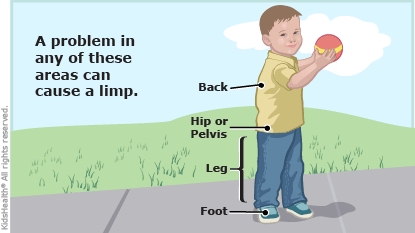Limp: How to Care for Your Child
Children limp (walk in an uneven or unsteady way) because of pain or weakness in the back, hip, leg or foot. Usually, the cause of limping is not serious. It often gets better without any specific treatment. Follow these care instructions to keep your child comfortable during healing.


-
For the next few days, have your child take it easy. It's OK to walk and do other activities that don't make the pain or limping worse.
-
If your health care provider says it's OK, you can give acetaminophen (Tylenol® or a store brand) OR ibuprofen (Advil®, Motrin® or a store brand). Follow the directions exactly to make sure you give the correct dose for your child's age and weight.

Your child:
-
continues to limp for more than a few days
-
has swelling or redness of the hip, leg or foot
-
can't walk at all
-
has worsening or severe pain
-
gets a fever or rash
-
has weakness, tingling or loss of feeling in the leg

What causes limping in children? Many things can cause limping in children. Some of the more common causes include:
-
muscle or joint pain that happens during or after infection with a virus like the flu
-
an injured or broken bone
-
a muscle strain, sprain, or bruise
-
an infection in a joint
-
a problem with the feet, such as a blister, callus, wart or ingrown toenail
What happens if the limping does not go away? Sometimes, it's not easy to find the cause of a limp, especially in younger kids who have trouble telling you where the pain is. If your child's limping does not get better, your health care provider may:
-
do blood tests
-
get imaging studies, such as an X-ray or MRI
-
send your child to a specialist for more testing or care